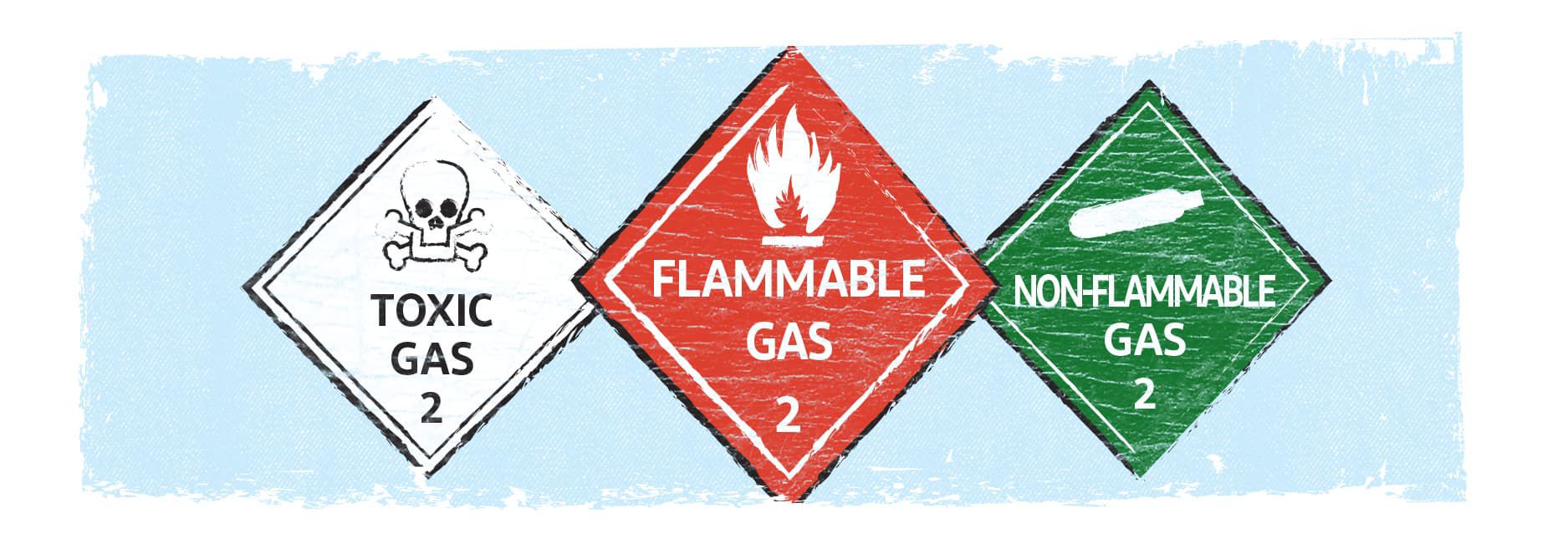Hazmat on the go – Transportation regulations: Gases
By Kathryn Novelli
Senior Marketing Analyst

Handling and transporting hazardous materials are the reality of a modern and dynamic supply chain. Whether the hazardous cargo is a final product destined for market or a byproduct of the production process that must be disposed of, hazardous materials transportation remains a necessary part of contemporary commerce.
Traveling with hazardous materials is serious business and maintaining safety is of the utmost importance. To help workers stay safe, the United States Department of Transportation (DOT), established in 1966, and its operating organizations oversee regulations and requirements for the safe transportation of hazardous materials.
The Federal Motor Carrier Safety Administration (FMCSA) and the Pipeline Hazardous Materials Safety Administration (PHMSA) work in tandem to advise and enforce regulations in relation to the DOT’s nine classes of hazardous materials.
The next stop on our Hazmat on the Go series is Class 2: Gases.
Hazardous gases, as defined by the DOT and FMCSA, include compressed, dissolved under pressure, or pressurized cryogenic liquids and liquefied gases and can be toxic, flammable or nonflammable. Examples of commonly transported hazardous gases include petroleum gases, like propane and butane, as well as chlorine gas and anhydrous ammonia. Uses for hazardous gases are wide-ranging, including use in household applications like cooking, heating and powering appliances, to applications as a refrigerant or agricultural fertilizer, in addition to inclusion in product manufacturing processes for pharmaceuticals, computers, automobiles and aircraft parts. While OSHA provides guidance for the storage, use and handling of hazardous gases in the workplace, many regulations for hazardous gases are overseen by the DOT, in conjunction with the PHMSA and FMCSA.
The DOT designates gases as a Class 2 hazardous material, which is further categorized into three divisions:
- Division 2.1: Flammable gases
- Division 2.2: Nonflammable, nontoxic gases
- Division 2.3: Toxic gases
These classifications are used for cargo labeling and vessel placarding, as required by the DOT.
Frequently, hazardous gases are transported via trains on railways, specifically in pressure tank cars. Pressure tank cars can carry all three division classifications for gases and include protective housings and no bottom fittings. Most pressure tank cars maintain pressure above 40 psi. When being transported via road, hazardous gases are often moved using pressurized road trailers. Different models of road trailers vary in appearance, function and allowable cargo, but most feature an emergency shut-off valve at the front of the tank, near the driver door.
Transporting hazardous gases can be extremely dangerous. On June 28, 2022, in Jordan, an accident involving a toxic chlorine gas explosion occurred which killed at least twelve people and injured 250. CCTV footage captured the moment when a crane malfunctioned while it had been hoisting a storage tank carrying around thirty tons of gas. The crane dropped the container onto the deck of a ship, breaking the container and engulfing the Aqaba Port in a poisonous, yellow chlorine gas cloud. Jordan’s civil defense force and area medics arrived at the scene immediately and took injured people to two nearby hospitals.
In case of an accident involving the transportation of hazardous gases, the operator must call the emergency response telephone number included on the shipping paper for the cargo, or if unavailable, contact an appropriate emergency response service. Emergency response actions vary depending on the type of hazardous gas released in an accident and the conditions of the accident, including the size of a leak, toxicity of the gas and the presence of fire. The use of chemical protective clothing and self-contained breathing apparatus (SCBA) is often required in addition to flame-resistant clothing when responding to emergencies involving flammable and corrosive or toxic gas. Furthermore, since many gases are heavier than air, they will spread along the ground and can collect in lower elevation or confined areas. Evacuation of the area and isolation of the accident are often vital in ensuring public safety.
Knowledge of transportation regulations and best practices for hazardous materials is paramount to keeping people safe, on and off the road. Through diligent adherence to safety standards and awareness of emergency response procedures, hazmat transporters can help keep roads safe for everyone.
To learn more about how to protect yourself from different hazardous materials and to find out which DuPont products offer suitable protection for your needs, visit SafeSPEC™.
Do you have a story you’d like to share about transporting hazardous materials? Email kathryn.novelli@dupont.com to discuss being featured in our next edition of The Glow Worm.
